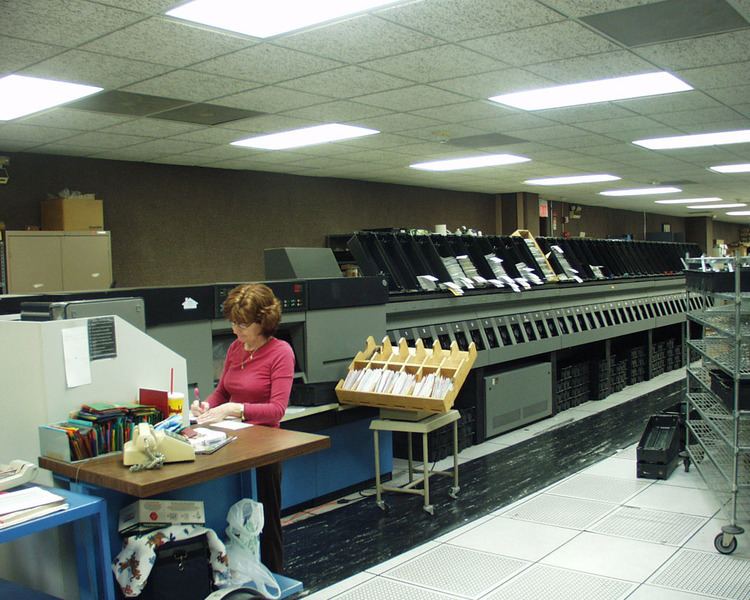 | ||
Prior to the introduction of computers, cheque processing was performed manually by each institution. The advent of computers necessitated the development of peripheral equipment that would aid in the processing of cheques and other MICR encoded documents. Machines were developed that could be used to read the MICR information encoded at the bottom of the cheques and other financial instruments, so that they could be sorted and the information passed to the processing system for computer posting. Some of these machines operated in an offline capacity to further sort cheques and other documents as required without online processing. Many firms were developing and designing hardware and software for use by financial institutions to perform their day-to-day operations, among those IBM.
Contents
IBM introduced the 3890 High Speed Document Processor in 1973. This piece of equipment is used by financial institutions to sort and tally all cheques, utility payment and gift certificates at the end of each banking day. The machine reads the magnetic ink characters (MICR) and/or the optical characters (OCR) that are encoded on the bottom of each document. This code line facilitates totalling the cheques and sorting them into pockets. The document process is designed to feed at a rate of 2400 six inch cheques per minute.
An application called Check Processing Control System (CPCS) is run on a main frame. It receives the data from the document processor and can store information from the cheques, including the bank number, branch number, account number and the amount the check was written for, as well as internal transaction codes. The 3890 can also operate in an offline mode using an SCI (Stacker Control Instruction) program.
The machine is made up of several modules, each performing specific task. At the far left of the machine is the control unit. Sort control programs, character recognition and host connection are handled by an IBM PC server in the control unit (3890/XP). Early A-F models used an IBM S/360 based processor with magnetic core memory. It links to all the electronic control systems and cabling that is required to operate the machine.
The next module is the left feed module. This section of the machine is where cheques are pulled into the transport path. The MICR line is magnetized and read in this part of the machine. The MICR information is passed to the control unit for additional processing. This module also has the ability to insert tracking documents into the stream of cheques in the transport. On Models A-F, the item numbering feature or INF was also found in the left feed module. The INF could print a unique 8 digit number on the back of each check.
The right feed module performs two functions. One is the input area, where up to 4800 cheques can be placed to be fed into the left module. Before this happens, all documents are “jogged” before they are moved into the transport. This process causes the cheques to be lined up better for feeding into the left feed module; institutions use an external jogger as well. The second function is the Programmable Item Number Endorse system or PINE, which appeared with the model XP1. It is a high speed ink jet printer used to print document tracking number on each cheque which goes through the machine. At the same time an “endorsement” stamp is sprayed on to show which institution has handled the cheque. On Models A-F, an “endorsement” stamp is used to show what institution has handled the cheque.
After this, the document passes through two optional modules. To meet the requirements of the American Banking Association, one of the two must be used. Until October 2003, the only legal way to provide long term archiving of cheques was microfilm. This is one of the optional modules. High speed strobe lights illuminate the cheques and mirrors direct the lit image through a camera onto film. The front and back of the cheque, plus the item number are transferred to the film.
The other optional module is the Image Capture Processor (ICP). High speed digital scanners generate pictures of the front and back of the check. To keep up with the speed that documents move by the scanners, four PC’s are used – one cheque directed to one PC, the next to the second and so forth. These images are consolidated to a fifth PC which sends the images to a host computer system, where the digital images can be stored on hard disks. After this they can be backed up using magnetic tapes for long term archiving. As of October, 2003, these images, rather than the physical cheques, can be used when institutions needs to exchange cheque information.
The final component on a 3890 is the stacker modules. Each module has six pockets, and the machine supports up to six stackers for a total of 36 pockets. The sort control program directs each document to the appropriate pocket. A cheque might be sorted according to the institution it is drawn against, a customer account, or a utility company. These pockets allow the physical cheques to be collected and stored in trays.
Programming
The 3890 is programmed by two methods. The first is SCI (Stacker Control Instructions), which are executed directly by the S/360 in the model A-F machines, and emulated by the PC in the 3890/XP. The 3890/XP added an additional method of programming, known as Native. This allowed programs written for the PC to make sort decisions. The API available to Native programs is the SPXSERV api.
Withdrawal
IBM withdrew the 3890/XP1 from marketing on September 27, 2005
